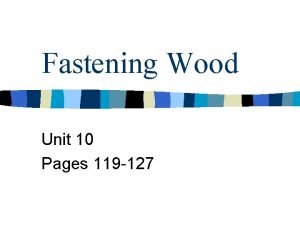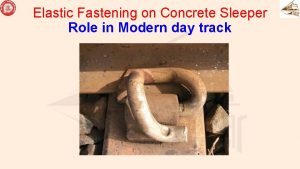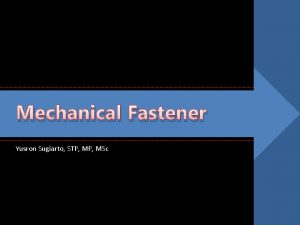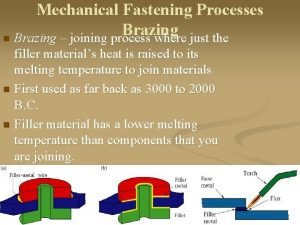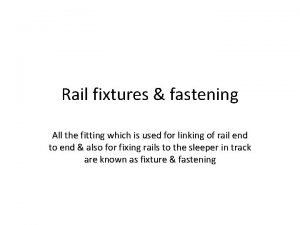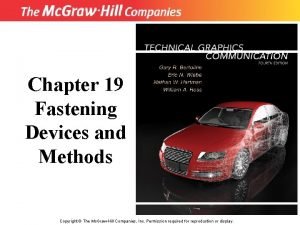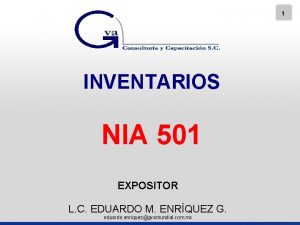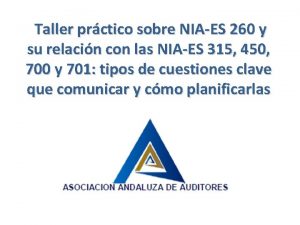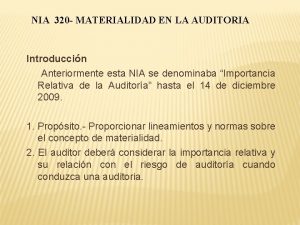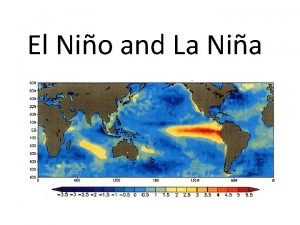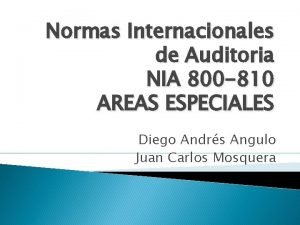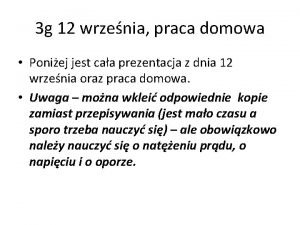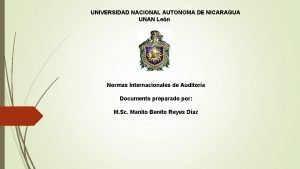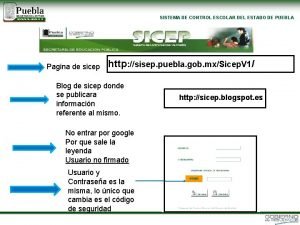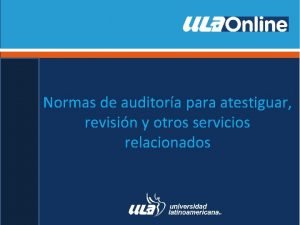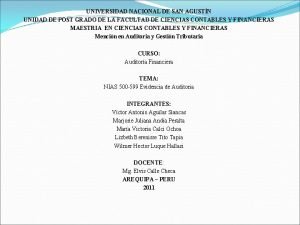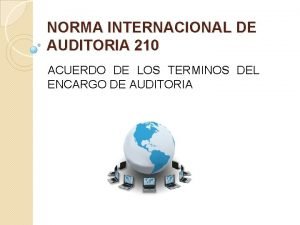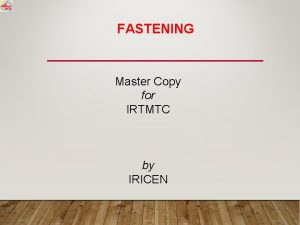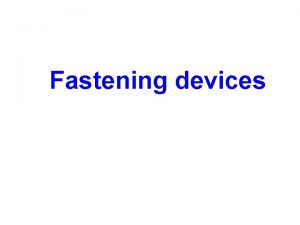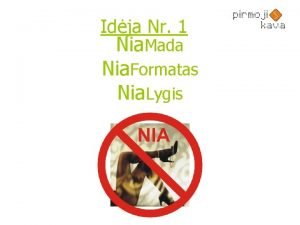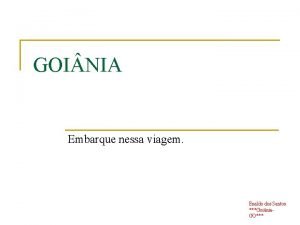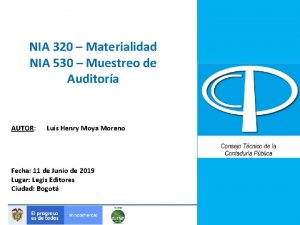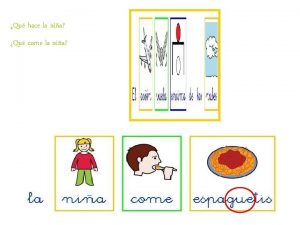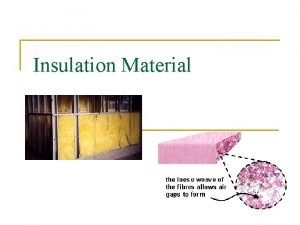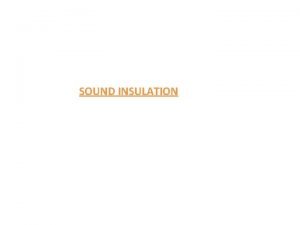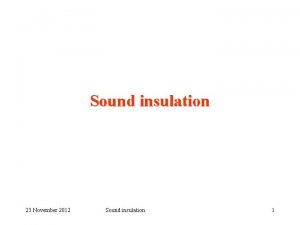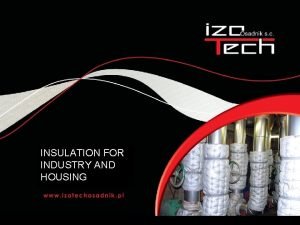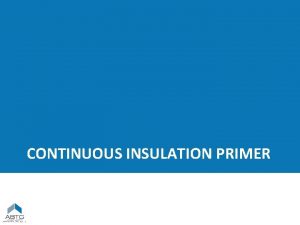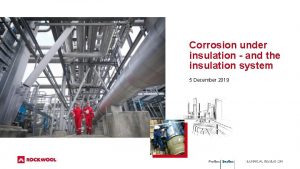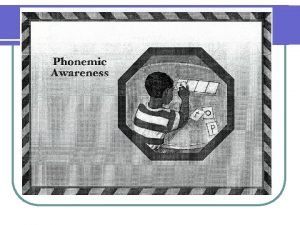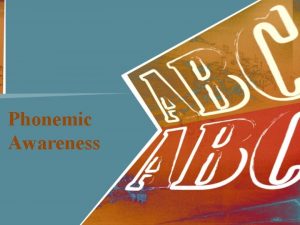NIA Insulation Awareness Guide to Insulation Fastening Guide






































- Slides: 38

NIA Insulation Awareness Guide to Insulation Fastening

Guide to Insulation Fastening Methods and Practices in Insulation Fastening: 1. What Is Stud Welding? 2. Application of Weld Pins 3. Application of Cup Head Pins 4. Application of Insulation Hangers (Spindles) 5. Application of Self-Stick Anchors 6. Application of Lacing Anchors 7. Application of Lacing Systems 8. Welding Application Gun Setup (4 Methods) 9. Voltage Settings 10. Welding Accessories and Consumables 2 Copyright NIA 2021. All Rights Reserved.

Guide to Insulation Fastening 1. What Is Stud Welding? STUD WELDING is a high-speed joining process in which a Stud or similar metal part can be affixed to a metal workpiece. The Process: The Stud is placed (with a hand tool called a Stud Gun) in contact with the base metal, and an arc is drawn, which melts the Stud base and an area of the metal workpiece. The Stud is then forced into the melted area and held in place until the metals resolidify. This high-quality fusion weld is completed in milliseconds by one of two major methods. 3 Copyright NIA 2021. All Rights Reserved.

Guide to Insulation Fastening TWO METHODS AVAILABLE Capacitor Discharge (CD) 1. What Is Stud Welding? CD Stud Welding Is a 115 Volt VAC Welding Process. 4 Copyright NIA 2021. All Rights Reserved.

Guide to Insulation Fastening TWO METHODS AVAILABLE ARC 1. What Is Stud Welding? Arc Stud Welding Is a Single or Three Phase Current Welding Process. 5 Copyright NIA 2021. All Rights Reserved.

Guide to Insulation Fastening 2. Application of WELD PINS A. Weld Pin in place. B. Install insulation on Pins. C. Press Washer on Pins to secure insulation. D. Either clip nail off at Washer or bend it over. 6 Copyright NIA 2021. All Rights Reserved.

Guide to Insulation Fastening 3. Application of CUP HEAD (or Cupped) PINS A. Position insulation. B. Press Cup Head Pin through insulation. C. Weld in place to complete installation. 7 Copyright NIA 2021. All Rights Reserved.

Guide to Insulation Fastening 3. Application of CUP HEAD PINS Special Notes A. An insulating paper washer or pressure-sensitive adhesive backing liner is required when welding through foil-faced insulation. This prevents unwanted arcing from foil to underside of Cup Head Pin. 8 Copyright NIA 2021. All Rights Reserved.

Guide to Insulation Fastening 3. Application of CUP HEAD PINS Special Notes B. Many insulators recommend Cup Head Pins to be 1/8” longer than the insulation thickness, dependent upon density of insulating material being installed, to avoid pins popping out due to the compressive recovery of the insulation. 9 Copyright NIA 2021. All Rights Reserved.

Guide to Insulation Fastening 4. Application of INSULATION HANGERS (SPINDLE ANCHOR) A. Wipe surface clean (dry non-painted, non-porous surface). B. Apply adhesive to one Anchor at a time with a putty knife. C. Immediately stick Anchor in place with twisting motion. D. Install insulation. E. Secure with Washer. 10 Copyright NIA 2021. All Rights Reserved.

Guide to Insulation Fastening 4. Application of INSULATION HANGERS (SPINDLE ANCHOR) Special Notes C. The twisting motion will assure an even spread of adhesive. The adhesive should protrude through the perforations and beyond the edges of the base. • Expect 700 -800 applications per gallon of adhesive. 11 Copyright NIA 2021. All Rights Reserved.

Guide to Insulation Fastening 4. Application of INSULATION HANGERS (SPINDLE ANCHOR) Special Notes D. Allow adhesive to dry thoroughly before hanging insulation, usually 24 -72 hours. Drying times will vary with temperature and with adhesive formula in use. • Recommend installation of hangers on 12 -inch center or 1 per sq. ft. 12 Copyright NIA 2021. All Rights Reserved.

Guide to Insulation Fastening 4. Application of INSULATION HANGERS (SPINDLE ANCHOR) Special Notes E. Secure insulation in place with selflocking washer and then bend over or clip off the nail point. • Use of anchor ½” longer than insulation thickness improves application for many users. 13 Copyright NIA 2021. All Rights Reserved.

Guide to Insulation Fastening 5. Application of SELF-STICK ANCHORS A. Wipe surface clean. B. Peel off release backing. C. Stick Anchor in place. D. Apply firm pressure. E. Allow to stand 15 -20 minutes. F. Install insulation and secure with washer. 14 Copyright NIA 2021. All Rights Reserved.

Guide to Insulation Fastening 5. Application of SELF-STICK ANCHORS Special Notes A. Must be applied to a clean, non-porous surface that is free of all oil, film, dust, rust, etc. 15 Copyright NIA 2021. All Rights Reserved.

Guide to Insulation Fastening 5. Application of SELF-STICK ANCHORS Special Notes B. Double-faced foam tape has a 1 -year shelf life. • Temperature range for foam tape is from -20°F to +180°F. • Best results are obtained when ambient temperature is above 40°F at time of application. 16 Copyright NIA 2021. All Rights Reserved.

Guide to Insulation Fastening 5. Application of SELF-STICK ANCHORS Special Notes C. Do not “twist” Anchor when applying Anchor. 17 Copyright NIA 2021. All Rights Reserved.

Guide to Insulation Fastening 5. Application of SELF-STICK ANCHORS Special Notes D. 20 pounds of pressure should be applied all around the base of the Anchor. • Not recommended on painted surfaces, drywall, or ceilings of metal buildings. 18 Copyright NIA 2021. All Rights Reserved.

Guide to Insulation Fastening 5. Application of SELF-STICK ANCHORS Special Notes F. Recommended load is 3 lbs. per Anchor (. 75 lbs. /sq. in. maximum) Use Anchors ½” longer than insulation thickness to improve installation. Do not “twist” anchor during application. 19 Copyright NIA 2021. All Rights Reserved.

Guide to Insulation Fastening 6. Application of LACING ANCHORS A. Prepare insulation cover or pad to be fabricated. B. Press Lacing Anchor through blanket. C. Secure Lacing Anchor with selflocking washer. D. Bend or clip off nail. E. Install removable insulation. F. Secure cover by lacing through hooks with lacing wire. 20 Copyright NIA 2021. All Rights Reserved.

Guide to Insulation Fastening 7. Application of LACING SYSTEM/HOOK A. Lacing Hook System • Install lacing hook with wire tie. • Secure with Lacing Washer. • Secure insulation by lacing through hooks. 21 Copyright NIA 2021. All Rights Reserved.

Guide to Insulation Fastening 7. Application of LACING SYSTEM/RING A. Lacing System/Ring • Install Lacing Washer and Lacing Ring. • Secure with Lacing Washer. • Secure insulation by lacing through rings. 22 Copyright NIA 2021. All Rights Reserved.

Guide to Insulation Fastening: Setup #1 #1 B Collet and B Stop Method 8. Weld Gun Setup for WELD PINS • B Collet and B Stop 23 Copyright NIA 2021. All Rights Reserved.

Guide to Insulation Fastening: Setup #2 #2 B Collet and Collet Protector 8. Weld Gun Set up for WELD PINS • B Collet and Collet Protector 24 Copyright NIA 2021. All Rights Reserved.

Guide to Insulation Fastening: Setup #3 #3 B Collet and Internal Stop 8. Weld Gun Set up for WELD PINS • B Collet and Internal Stop 25 Copyright NIA 2021. All Rights Reserved.

Guide to Insulation Fastening: Setup #4 #4 Magnetic Chuck 8. Weld Gun Setup for CUP HEAD PINS • Magnetic Chuck 26 Copyright NIA 2021. All Rights Reserved.

Guide to Insulation Fastening VOLTAGE SETTINGS for CD 9. VOLTAGE SETTINGS for CD The chart settings shown to the right are “reference” settings to be used as starting points. Actual voltage settings may vary depending upon the conditions or each application and use. 27 Copyright NIA 2021. All Rights Reserved.

Guide to Insulation Fastening ACCESSORIES AND CONSUMABLES 10. Many Accessories and Consumables Are Available If problems occur, call your local Rep or Manufacturer for solutions. Field Support is key with respect to Commercial and Industrial Insulation Fastening. 28 Copyright NIA 2021. All Rights Reserved.

FAQs Q. My Weld Pins are not welding consistently. Is there something wrong with my Pin Welder? • If your Pin Welder is charging and discharging, most likely it is not the Welder itself. Examine the base metal, the setup, and the condition of your cables and consumables. • Is the base metal oxidized or dirty? Weld current must travel back to the Ground. If the base metal cannot carry current properly, the weld results will vary. Prep the surface. 29 Copyright NIA 2021. All Rights Reserved.

FAQs Q. My Weld Pins are not welding consistently. Is there something wrong with my Pin Welder? • Are your Consumables worn out? Weld Pins and Cuphead Pins require snug connections to B Collets or Mag Chucks. Any loose-fitting connections will cause arcing. This arcing takes valuable current from the weld end of the pin. Replace worn out consumables. • Normal wear-and-tear is to be expected. Examine your connections, both the Weld Cable Connections and the Ground Connections. Replace or reconnected any worn cables. 30 Copyright NIA 2021. All Rights Reserved.

FAQs Q. I am Pin Welding onto carbon steel with no issues, but sometimes when I weld on Galvanized material, I am experiencing some failures. What is the problem? • Zinc does not carry current. More and more, especially with imported galvanized sheet metal, this Zinc coating can be very thick and unevenly distributed on the sheet. This can be resolved with a “reverse polarity” setup at the Welder. • Reverse polarity means to simply switch (at the Cam Lok) the Weld Cable, typically negative, and the Ground Cable, typically positive. This reverses the current flow and improves weldability. 31 Copyright NIA 2021. All Rights Reserved.

FAQs Q. Can I use Stainless Steel Weld Pins on a Mild Steel surface and vice versa? • Yes. Stainless and Mild Steel will weld, no problems. • The only instance where like metals are an absolute requirement is when welding Aluminum. 32 Copyright NIA 2021. All Rights Reserved.

FAQs Q. My Pin Welder is recharging slow, what is the problem? • Most Pin Welders require 115 VAC and 20 Amp service. This 20 Amp service is not a continual draw on the Amps, but rather a draw only when recharging. Most Pin Welders will “spike” at about 16 -17 Amps when recharging. On site, you cannot “starve” that Pin Welder of those Amps. Typically, there are two causes: 1. Too small of a diameter extension cord, starving Amps on recharge. Replace extension cord to recommended diameter. 2. Many operators running equipment on the same AC line, taking those valuable Amps. Run extension to another AC line or generator. 33 Copyright NIA 2021. All Rights Reserved.

FAQs Q. I am pushing down hard on my Pin Gun, and I am not getting good welds. What am I doing wrong? • Let the Pin Gun do the work, not your body weight. Ideally the operator finds the middle of the spring, or about 50% of compression, then pulls the trigger. • If the operator is too heavy on the Pin, it will starve the molten weld zone of needed oxygen to solidify the weld. • If the operator is too light, the molten weld zone will solidify before the pin travels down to make the weld. 34 Copyright NIA 2021. All Rights Reserved.

FAQs Q. I am using solvent-based liner adhesive. Is there a fire hazard when welding Cup Heads? • Yes. Let all solvent based liner adhesives dry fully according to the manufacturer's specifications and directions. • Or use a water-based liner adhesive. 35 Copyright NIA 2021. All Rights Reserved.

FAQs Q. I am using Self-Stick Anchors from the shop that are over a year old and they are failing. What am I doing wrong? • The active solvent in the PSA tape of a Self-Stick will begin to evaporate after a year. Replace your Self-Stick Anchors. • Self-Sticks are not recommended for painted or porous surfaces, drywall, and ceilings of metal buildings. • Surface must be free of all oil, film, dust, rust, etc. 36 Copyright NIA 2021. All Rights Reserved.

Resources NIA has numerous resources to help you every day. NIA Resources § www. Insulation. org § Insulation Outlook Magazine § NIA’s Annual Buyer’s Guide Images and instructions published with permission from Midwest Fasteners. 37 Copyright NIA 2021. All Rights Reserved.

NIA’s Online and Social Media Connect with us! Insulation. org Insulation. Outlook. com Insulate. Metal. Buildings. org NIA’s FACEBOOK PAGE www. facebook. com/NIAinfo NIA’s VIMEO CHANNEL www. vimeo. com/NIAinfo NIA’s TWITTER FEEDS www. twitter. com/NIAinfo www. twitter. com/Insulation. Info NIA’s LINKEDIN PAGE www. linkedin. com/company/NIAinfo NIA’s YOUTUBE CHANNEL www. youtube. com/NIAinfo 38 Copyright NIA 2021. All Rights Reserved.
 Cvs privacy awareness training answers
Cvs privacy awareness training answers Chapter 10 dado joint answers
Chapter 10 dado joint answers Erc rail clip weight
Erc rail clip weight On a ship, its corresponds to a floor in a building
On a ship, its corresponds to a floor in a building Which is best for fastening wood at high stress points?
Which is best for fastening wood at high stress points? Kekuatan baut fisher
Kekuatan baut fisher Mechanical fastening methods
Mechanical fastening methods Unit 6 fasteners
Unit 6 fasteners Fixture and fastening in railway
Fixture and fastening in railway Fastening devices
Fastening devices Difference between permanent joint and temporary joint
Difference between permanent joint and temporary joint Snap fit joint
Snap fit joint Adrd payline
Adrd payline Aseveraciones de inventarios
Aseveraciones de inventarios Nia jesus
Nia jesus Aci meaning in network
Aci meaning in network Nia in spanish
Nia in spanish Si9a
Si9a Nia 120
Nia 120 Materialidad en auditoria
Materialidad en auditoria Nia nio
Nia nio Nia 545
Nia 545 Nia 800
Nia 800 Praca wrze��nia
Praca wrze��nia Nia 400
Nia 400 Nia seating
Nia seating Pozostali bohaterowie karolci
Pozostali bohaterowie karolci Control escolar puebla
Control escolar puebla Hello nia
Hello nia Nia 800-899 areas especializadas
Nia 800-899 areas especializadas Nia 505 confirmaciones externas
Nia 505 confirmaciones externas Nia 450
Nia 450 Nia 500 evidencia de auditoría
Nia 500 evidencia de auditoría Nia 200
Nia 200 Nia magoulianiti-mcgregor
Nia magoulianiti-mcgregor History of nia
History of nia Nia automata
Nia automata Nia bonita
Nia bonita Norma 210 de auditoria
Norma 210 de auditoria

